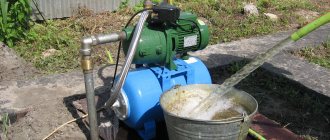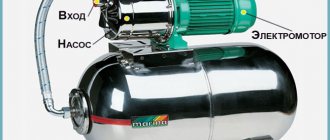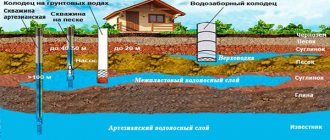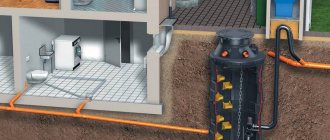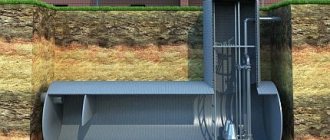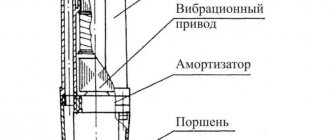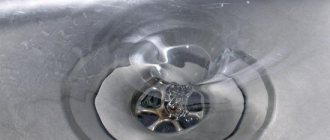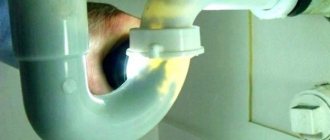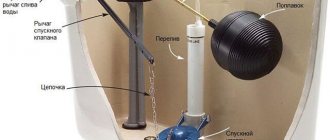The main working element of an autonomous water supply system is the pumping station.
This term refers to a set of components that maintain constant pressure in the pipeline.
Their large number causes a variety of causes of technical malfunctions.
For example, many users are concerned about the question: why does the pumping station often turn on? What to do? There is no definite answer to this - several factors influence the rhythm of operation of pumping equipment.
Equipment design
A standard water supply pumping station for a private home is a collection of individual devices that are interconnected.
To repair such equipment yourself, you must take into account all the design features, as well as be able to correctly determine the cause of the malfunction.
Pumping station design:
- a submersible or surface pump that pumps liquid and maintains stable intra-system pressure;
- a pipeline with a check valve that prevents the backflow of water in the event of a shutdown of the pumping equipment;
- a membrane tank or hydraulic accumulator, which is a sealed container divided into parts by an elastic membrane and designed to create a small reserve of water;
- a control unit installed in the area between the membrane tank and the pump, and represented by a pressure gauge and pressure switch.
Control devices allow you to correctly assess the level of intra-system pressure, control the operation of the pumping system, turning them on and off in a timely manner.
The pumping station turns on after the pressure in the system drops to 1.0-1.6 atmospheres. The equipment turns off only when the upper pressure readings are reached.
For example, in a private one-story house, the standard upper pressure threshold is 2.6-3.0 atmospheres.
Source: https://ru-canalizator.com/vodosnabzhenie/oborudovanie/nasosnaya-stantsiya.html
Other reasons
If problems with equipment operation are not directly related to the station, then it is recommended to perform a thorough audit of the entire pipeline.
Frequent activation of the pump may occur in the following cases:
- the formation of fistulas or depressurization of connections in the pipeline, causing leaks and causing a loss of pressure in the system;
- blockage in the supply pipeline , accompanied by a sharp decrease in the throughput of the pumping station;
- a significant drop in the water level at the water supply source.
Leaks in hidden parts of the pipeline can only be detected during a step-by-step inspection of all sections, with pressure monitoring using a pressure gauge.
Segments that are not damaged, in the absence of water analysis, give unchanged pressure gauge readings for a quarter of an hour.
Frequent switching on of the pumping station can be caused by a blocked check valve or the presence of a foreign object in the pipeline.
In this case, you will need to disassemble and flush the water supply fittings.
check valve that has lost its seal
Problem with the water supply of a private house
House owners are distinguished by ingenuity and stubbornness, which help them to quickly provide the residents of the house with clean water, normal plumbing conditions and peace of mind.
Autonomous water supply, as well as sewerage in the form of shambo or specialized pits, is the best economical option without additional costs, the functionality of which is not affected by external factors, unscheduled power outages and unexpected interruptions in water supply.
Pumping stations that lift water from a well greatly simplify life, but even the deferred mechanism can have annoying failures. Owners of pumping systems sometimes encounter a problem when the pumping station turns on frequently.
The reasons for such an unpleasant phenomenon may lie in the structure of the pump, station parts, non-compliance with operating rules and other factors that are not always in your control. Why does the station for supplying water to the house fail? The answer to this question requires an integrated approach.
Preservation during a break in operation
Such measures are designed to extend the life of the equipment and help maintain high performance indicators.
Conservation rules:
- disconnecting the equipment from the power supply and turning off the safety circuit breaker;
- releasing pressure in the system;
- disconnecting the suction hose and water pressure;
- checking the pressure in the hydraulic accumulator;
- draining residual water from pumping equipment.
You will learn about the reasons that force the mechanism of turning the water supply pumping station on and off frequently while watching the video.
Operating principle of pumping stations
Clean, healthy and completely safe water from a well in the yard is the most common solution to the problem of access to drinking water in a country house.
This is exactly the case when long-tested devices do not need advertising. Wells are easy to use, easy to clean and durable compared to expensive tanks or wells.
With the help of modern technologies, manufacturers did not disrupt the working, functional system, they only modified it for your convenience.
Pumping stations of different power and operating principles will simplify the process of collecting water, eliminating long and tedious mechanical lifting of water from the well and its transportation to the house.
Regardless of the principle of operation, pumping stations have a similar structure of main parts. So, the general structure includes a pump, a tank for storing collected water (hydraulic accumulator) and parts connecting them (relays, valves, etc.).
Thanks to the pumping station, water does not immediately flow from the well to your tap. Using a relay that regulates the pressure inside the system, water from the well is pumped out by a pump, then enters a container and is stored there until the tap is opened.
When the accumulator is empty, the pumping station turns on the pump and re-takes water. The station operates and turns off only when necessary; in other cases, the entire mechanism is in “sleep” mode, without consuming expensive electricity.
Additional parts of the mechanism, such as a check valve, ensure the correct operation of the device, an auxiliary filter ensures cleaning of the water coming to your table, and a relay controls the water intake, preventing the well from drying out.
The picture looks clear, and no special skills are needed to understand the essence and problems in the operation of the pumping station. Therefore, when the pumping station often turns on and off, what to do and what to do, you can decide on your own without outside help.
Malfunctions of the hydraulic accumulator for water supply systems, DIY repair and adjustment methods
An important aspect that ensures the comfort and coziness of a country home is the stable and uninterrupted functioning of an autonomous water supply system.
Therefore, many owners of houses and cottages, first of all, pay special attention to the correct installation of the water supply system and all its structural elements, since the supply of water from a well or well directly depends on their work. As a rule, an autonomous water supply system consists of the following components:
As a rule, an autonomous water supply system consists of the following components:
- water intake pump,
- hydraulic accumulator or hydraulic tank,
- main pipeline.
Undoubtedly, for the normal functioning of the water supply, the trouble-free operation of all the above structural elements is important.
But today we want to focus your attention on the hydraulic tank, which plays a key role in an autonomous water supply system, and also on the uninterrupted functioning of which largely depends on whether you will have water in your tap or not.
Therefore, in this article we will talk about what a hydraulic accumulator is, what tasks it performs, and also give recommendations regarding the elimination of various types of malfunctions and breakdowns of this important element of an autonomous water supply system
Therefore, in this article we will talk about what a hydraulic accumulator is, what tasks it performs, and also give recommendations regarding the elimination of various types of malfunctions and breakdowns of this important element of an autonomous water supply system
What does it consist of?
A water storage device of this type, as a rule, consists of the following structural components:
- device platform,
- metal body, which can be made of both high-strength steel and stainless steel,
- accumulator membrane or pear-shaped rubber reservoir,
- flange with valve for water supply,
- nipple designed for pumping air into the device.
Why is it needed?
Many ordinary people who are going to install a water supply system, having familiarized themselves with the design of the hydraulic tank, still do not fully understand why this unit is needed in an autonomous water supply system.
For greater awareness, it is worth noting the fact that the hydraulic accumulator is designed to perform a number of the following tasks:
- accumulates a reserve supply of water in case of emergencies in water supply,
- stabilizes excess pressure that appears in the water supply,
- protects the pipeline from water hammer that occurs when the water intake pump is turned on,
- maintains stable water pressure in the pipes when the pump is turned off,
- promotes long-term operation of the pump, since the pump unit is turned on much less frequently,
- promotes uniform water supply at moments of maximum consumption.
You may be interested in an article about repairing pumping stations for your home with your own hands.
Read an article on how to make a hydraulic accumulator yourself here.
How to repair
Analyzing the functions performed by the hydraulic tank, one can involuntarily come to the conclusion that the functioning of the entire water supply system generally depends on the stable operation of this device.
Therefore, an important fact is that if various types of malfunctions and failures occur, they will urgently need to be corrected.
Among the possible malfunctions of the hydraulic accumulator, the following points can be highlighted:
Why does the pumping station often turn on and off - types of breakdowns and their elimination
Why does the pumping station not perform its assigned functions?
Even if you installed the station correctly, connected all its parts correctly, provided it with protection from power surges, checked the pressure in the pump, the pumping station is subject to breakdowns and malfunctions, and you must be prepared for such little things.
The water supply station turns on often, what should I do? Consider all the problems comprehensively, because the system for collecting and transporting water to a country house is similar to the human body and every symptom will certainly lead you to a faulty part.
There are typical, even standard and widespread problems that beset pumping stations. Such as:
- fuse burnout, leading to a lack of power to the entire system;
- lack of proper amount of water in the system or in the well;
- incorrect pressure adjustment (pressure is not systematized);
- entry of air, debris and other foreign objects into the system;
- problems with the tank, check valve;
- impeller blocking due to low pressure;
- incorrect relay settings.
All these reasons lead to malfunctions in the operation of the pumping station, and as a result, the station begins to constantly turn on and off. It is simply impossible to keep such a system under control. Troubleshooting is done immediately, without waiting for the device to miraculously heal.
Repair work precedes the complete emptying of the station, then the entire system is cleaned of debris, pollution, sludge, and depending on the causes of the problems, the components are changed, the pressure is adjusted and the operation of the relay, pump, and filters is adjusted.
If the suction of the required amount of water is disrupted, liquid is introduced into the system, the suction level in the pipeline is adjusted and the valve is cleaned.
The pumping station works often, what should I do? The most common problems leading to such malfunctions in the operation of the station will be a damaged membrane, slight pressure in the tank, or an opening of the valve.
In such situations, the membrane or tank is completely replaced with new components, cracks and gaps caused by corrosion are sealed, air is added to the tank and the check valve is closed.
Source: https://vodospec.club/nasos/nasosnaya-stanciya-chasto-vklyuchaetsya-i-vyklyuchaetsya-chto-delat.html
Incorrect operation of the pressure regulator
One of the reasons leading to the constant switching on of the pressure pump is incorrect operation of the pressure regulator. To make sure that it is working properly, you need to do a number of certain actions.
The first step is to check the correctness of the readings of the built-in pressure gauge, if one is included with the pumping station. This can be done using a car pump with a built-in pressure gauge.
After making sure that the pressure gauge is “honest,” begin checking the adjustment unit:
- Remove the protective cover from it.
- Pump air into the battery cylinder through the safety valve, thus creating operating pressure in the system at the minimum acceptable level.
- By turning the screw on the large spring counterclockwise, lower the pressure threshold at which the pump automatically turns on.
- Bleed the air and pump it back up, repeating the procedure several times.
The automatic relay must operate when the minimum pressure threshold specified by the manufacturer is reached in the accompanying documentation - instructions or operating instructions for the pumping station.
Failure of the equipment operating mode can also be influenced by an overestimated maximum threshold set on the relay. It should be set at 95% of the maximum permissible pressure in the autonomous water supply system.
Don’t be lazy to check the condition of the machine’s inlet. If it is clogged with dirt, the equipment will not work properly. To eliminate this reason, it is enough to clean with a stiff brush.
Checking the injection pump
The pumping station will often turn on even if the pump is not provided with sufficient power. The pump impeller will not be able to develop the required power.
In this case, the pump will not be able to create maximum pressure in the pipeline; in order to fill the pipes with water, it will have to work almost without interruption.
A power deficiency may be the result of a malfunction of individual parts of the pump - electrical or mechanical. Malfunctions of the power supply also contribute to this problem.
The main reasons for the lack of power:
- Salinization of the pump inlet and outlet pipes: can be eliminated by mechanical cleaning or rinsing with cleaning solutions.
- Oxidation of the contact surfaces of the terminal box: they should be cleaned with fine sandpaper, having first disconnected the pump from the power source.
- Unstable voltage in the electrical network: its fluctuations are checked while the pumping station is running. This drawback can be eliminated by connecting a voltage stabilizer.
Over time, individual components of the mechanical part of the pump wear out, which leads to a decrease in the maximum possible pressure level in the system.
You can check the pump's capabilities visually by disconnecting it from the outlet water supply. A weak stream of water at the outlet of the pump indicates a high degree of wear of its parts. Most of them cannot be repaired, so you will have to replace the entire worn-out unit.
Checking the pressure accumulator
The next step in finding the reasons for frequent pump starts is to check the serviceability of the hydraulic accumulator. If the container is damaged, this will lead to water leakage and, as a result, to a catastrophic drop in pressure in the pipeline.
A highly stretched rubber membrane will have the same effect. How to check the integrity of the tank? Press the valve nipple (it is located on the part of the battery filled with air). If air is released from it, the integrity of the container is not compromised.
The appearance of water from the valve indicates damage to the membrane. It will have to be changed. If the situation develops unfavorably, the only way out is to completely replace the entire battery.
Other Possible Causes
You have checked the pressure switch and adjusted it. The pump of your station develops the necessary power, and the battery is as good as new - and the installation continues to turn on after a short period of time or even works without a break. Leave the station alone and start inspecting the pipeline.
The pump will turn on frequently if one of the following problems occurs:
- Fistulas have formed on the pipes or their connections have become depressurized. The presence of leaks in the network inevitably leads to a loss of pressure.
- The supply pipe is clogged and clogged with debris, as a result of which its throughput has sharply decreased.
- The water level in the source dropped and its filling slowed down.
The search for leaks in hidden sections of pipelines is carried out by step-by-step inspection of individual network segments.
The pressure in each of them must be monitored by installing a pressure gauge. The area being tested can be considered intact if, in the absence of water intake, the reading on the pressure gauge remains unchanged for 10-30 minutes.
Frequent switching on of the pumping station can also be caused by blocking the check valve with some foreign object. The blocking element can be removed by disassembling and washing the water fittings.
By the way, maybe, having disassembled the check valve, you will see that it has simply worn out and lost its tightness. Since this item is a consumable item, simply replace it with a new one.
Source: https://aquacomm.ru/vodosnabzenie/zagorodnyie-doma-v/avtonomnoe-vodosnabzhenie/istochniki/pochemu-nasosnaya-stanciya-chasto-vklyuchaetsya.html
Checking the pressure accumulator
The next step in finding the reasons for frequent pump starts is to check the serviceability of the hydraulic accumulator.
If the container is damaged, this will lead to water leakage and, as a result, to a catastrophic drop in pressure in the pipeline.
A highly stretched rubber membrane will have the same effect.
How to check the integrity of the tank? Press the valve nipple (it is located on the part of the battery filled with air). If air is released from it, the integrity of the container is not compromised. The appearance of water from the valve indicates damage to the membrane. It will have to be changed.
If the situation develops unfavorably, the only way out is to completely replace the entire battery.
Typical faults and their elimination
Below we will consider a number of problems and malfunctions that may arise during the operation of a pumping station.
The pump rotates, no water enters the system - the check valve is not working properly
Reason: The tightness of the conductive pipelines is broken, the check valve is not working correctly, there is no water in the pipeline or pump.
Solution to the problem: first, check for the presence of water in the pipeline or pump. If it is missing, you just need to add it to the pump through the hole provided for this purpose or lower the suction hose (or the pump itself) deeper.
The maximum permissible distance between the pump and the water level must be maintained. Now you need to check the condition of the check valve and the tightness of the joints, and then eliminate the detected problems.
If all these measures do not help, the pump may be damaged by abrasives that have gotten into the water, for example, sand. In this case, you will have to disassemble the pump and replace its impeller or housing. In some cases, it is necessary to install a new pump.
Please note that before starting work it would not hurt to check the voltage in the electrical network. If it is insufficient (a typical situation in rural areas), the pump will not pump water, although it will turn on.
The station operates jerkily - the hydraulic tank is damaged
Reason: The answer to the question why the pumping station turns on too often is most often that some part of the hydraulic tank is damaged. Because of this, the equipment does not build up pressure.
Solution to the problem: First you need to press the nipple located on the back of the tank. If water flows out of it (air should come out), then the inner membrane is torn and should be replaced.
Another possible reason why the pressure in the unit’s hydraulic accumulator does not correspond to the normal value is a violation of the seal of the housing.
You need to find a crack or hole and seal it. Sometimes, to solve the problem, it is enough to simply pump the missing amount of air into the tank using a conventional pump. The standard value of pressure in the tank is 1.5-1.8 atmospheres.
The missing air can be pumped into the membrane tank through a standard threaded fitting with a spool valve.
It should be noted that sometimes water flows intermittently due to a leak in the joints of the suction pipeline. It must be checked along its entire length and any cracks found must be repaired.
Doesn't turn on
Cause: No power supply.
Solution to the problem: It is necessary to check and possibly clean the burnt contacts of the pressure switch, and check the integrity of the winding. The fact that the engine has burned out will become clear from the smell characteristic of burning insulating materials.
It turns on but does not rotate - the reason is the capacitor or impeller
Reason: the condenser is broken or the impeller is “stuck” to the pump body. This situation often occurs with pumps that have been sitting idle for several months.
Solution to the problem: To start a blocked impeller, just turn it by hand a couple of times. After this, the pump should turn on. If the capacitor is broken, it will have to be replaced.
The unit does not turn off and works constantly - the relay is not adjusted
Cause: The pressure switch is malfunctioning.
Solution to the problem: It is necessary to adjust the pressure switch of the pumping station. To do this, use two springs located on the relay: large and small.
The large spring is responsible for regulating the lower pressure limit, and the small one regulates the difference between the minimum and maximum values. All manipulations with the pressure switch must be done extremely carefully.
To find out the reasons why the equipment does not turn off, you should definitely check the condition of the pressure switch inlet. Sometimes it becomes clogged with particles and sediments contained in the water. In this case, the hole must be cleaned and the operation of the pressure switch checked.
What to do and how to fix the problem
Naturally, first you need to find out what is causing this problem. Let's move on from the simple.
1. Pressure in the accumulator. On the rear wall of the hydraulic tank there is a pneumatic valve, which is closed with a plastic cover.
We remove the cover; for easy unscrewing there are special recesses for fingers.
Let's check if there is any air in the hydraulic tank. We press the nipple with a match, the characteristic sound of escaping air will be heard. There is no sound, which means the tank is empty.
You can skip this procedure and immediately use the pressure gauge. According to the rules, it should be 0.2 bar below the minimum starting pressure. Read more about this here. If the indicator is less than the required level, we take a pump, I use a regular manual one. After pumping it up a little, we check the pressure.
Important point: first disconnect the pumping station from the network, open the tap (mixer) and drain the water.
How to determine the required pressure without a pressure gauge? I do this procedure by eye. When we pump air into the tank, water begins to flow from the tap. You need to pump until the pressure becomes almost the same as if the pumping station was connected to the network and raising water.
It is recommended to check the pressure once a month.
2. Membrane integrity. Again, press the match on the pneumatic valve; if water flows out of it, the bulb is definitely torn and will need urgent replacement.
To get to it, I needed to disconnect the pumping station from the suction line, and also remove the pressure hoses from the outlet located on top.
We unscrew the bolts that secure the tank lid, which also presses the membrane. We take out the torn bulb, rinse and dry the tank. We assemble in the reverse order with a new membrane.
By the way, the rupture may be due not only to the fact that the membrane has lost its qualities or worn out. This may occur due to insufficient air in the tank.
3. Check valve. To check, disconnect the pumping station from the suction line; no water should flow out of the valve.
If the valve is leaking water, do not rush to buy a new one. Remove it and carefully inspect it; it is possible that a foreign object has gotten inside and is preventing the valve from working correctly.
We have looked at the possible reasons why the pumping station often turns on. It is better not to cause breakdowns at all, to carry out maintenance on time. Let us remind you that the average service life of a pumping station is 5 years.
A few words about adjusting the pressure switch
It should be remembered that the regulation of the pressure switch of the pumping station must be treated with great care. If this unit is not adjusted correctly, it can lead to serious damage to the entire station, and the manufacturer's warranty does not apply to such cases.
First you need to achieve the correct pressure in the accumulator. To do this, the device is disconnected from the network, and the water is completely drained from the tank. Then, using a pump with a pressure gauge or a household compressor, the required level of pressure is created in the hydraulic tank.
Now you need to unscrew the plastic cover on the pressure switch to gain access to the control springs.
The minimum pressure to turn on the pump is adjusted using a large spring. Turning the spring clockwise increases this indicator, and turning it counterclockwise decreases it.
To set the required range between the maximum and minimum pressure limits, rotate the pressure differential adjustment spring (1, see figure). Turning the nut clockwise expands the range, while turning it counterclockwise narrows it.
Then the pressure switch cover must be replaced, fill the pumping station with the required volume of water and connect the power supply. The maximum pressure value in the system should be no more than 95% of the maximum possible outlet pressure, which is indicated by the manufacturer in the data sheet.
Source: https://instanko.ru/drugoe/nasosnaya-stanciya-rabotaet-ryvkami.html
Membrane for a hydraulic accumulator, how to replace it if it malfunctions
The normal functionality of the home water supply system depends on the health of the accumulator. If there are malfunctions in the water supply network, it is necessary to immediately determine the cause of the malfunction and repair the equipment. Otherwise, more serious breakdowns and irreversible failure of all equipment may occur. The most common cause of failure is the accumulator membrane. We will find out how to check it, replace it and diagnose the system.
How to check and diagnose faults
Most hydraulic accumulator malfunctions can be corrected independently. All reasons can be divided into several groups.
Table 1. Malfunctions in hydraulic accumulators
Start draining the water.
If air escapes, the membrane has mechanical damage.
lack of compressed air in the tank.
Pumping air to the required pressure
Recommendations for servicing hydraulic accumulators:
How to check the initial pressure in a container:
- Disconnect the tank from the system.
- Drain the water.
- Connect the pressure gauge to the nipple.
- If the readings are lower than the default ones, it is necessary to pump up the pressure to working pressure (with a car compressor, for example).
Membrane selection
Hydraulic accumulators are available in vertical and horizontal versions. Accordingly, membranes are also distinguished in various shapes and designs: cone-shaped, cylindrical, spherical, ribbed.
When replacing a unit, you should purchase a product with similar characteristics - size, volume, neck diameter, maximum temperature of the working environment, material, operating pressure, etc.
Replacement cost
The membrane is the element of equipment that most often fails, because... is subjected to constant compression and stretching. The cost of replacement depends on the type of tank, capacity, type of membrane, manufacturer.
If the water supply system is operated continuously, it is advisable to purchase a more expensive membrane that can withstand a greater number of operating cycles.
The cost of models from imported manufacturers reaches half the cost of the hydraulic accumulator itself. At the same time, the nominal service life of products is several times higher than cheaper ones.
Replacing the membrane
If you have minimal skills in working with plumbing equipment, replacing the membrane on the hydraulic tank is not difficult. Following the correct procedure, replacing a unit takes a minimum amount of time:
- Disconnecting the tank from the water supply.
- Remove excess air pressure using the nipple.
- Drain the water from the container.
- Remove the pressure gauge, freeing up space for the membrane to exit.
- Remove the non-working part.
- Install a new membrane and secure the pressure gauge.
- Pump up pressure 0.2 less than the lower pressure of the pump relay.
- Install back.
After this, it is necessary to check the functionality of the water supply system. To do this, you need to fill the system with water and check the operation of the container.
Repair or how to seal
The membrane can be repaired by vulcanization. This method can extend its service life by several weeks until a working product is purchased and installed. But any repairs are a temporary measure and in any case you will have to buy a new one.
Hydraulic accumulator without membrane
In addition to standard factory-made hydraulic tanks, you can make such a device yourself. A hydraulic accumulator without a membrane is a regular water tank because... It is the membrane that helps maintain pressure in the system. It is much easier to buy an inexpensive ready-made hydraulic accumulator.
In order to build a hydraulic accumulator yourself, you need the following materials:
- tank (container) with a volume of at least 30 l,
- shut-off valves,
- ball valve,
- half inch faucet,
- fasteners (washers and nuts),
- sealant (sealant),
- rubber gaskets,
- nipple,
- fittings (tee, screw).
- Make holes in the container (on the lid and bottom, on the side).
- Install a half-inch tap in the upper hole (on the lid), seal the joint with gaskets and sealant, and secure with washers.
- Place a tee on the tap.
- Fix a ¾ shut-off valve in the lower hole and place a tee on it.
- Install a ball valve on the side hole.
A faulty hydraulic accumulator can affect the operation of the entire water supply system. Using the tips and methods described in the article, you can easily troubleshoot your home plumbing system. Timely prevention can prevent serious breakdowns and premature failure of hydraulic tanks and the entire system as a whole.
Preventive measures
As can be seen from the above, the reason why the pumping station is not working correctly is difficult to find if you do not have certain skills in this.
Below are the basic rules; following them will help minimize the risk of problems that were described in the previous sections.
Rules:
- Plastic pipes should not be twisted, nor should they have strong bends.
- The pipe joints must be carefully soldered and covered with sealant.
- When the depth of the well from which water is supplied is more than 5 meters, then the diameter of the pipes must be selected as large as possible based on a particular case.
- All lowest points of moisture supply to the room must have drains. This will help when the pipeline will be operated during the cold season. This way you can avoid freezing of water in the system.
- The station itself must be firmly attached to the base and not dangle.
- The pipe through which liquid will be sucked from the well should not dangle there, and should also be equipped with a filter or mesh to prevent dirt particles and foreign objects from entering the system.
When the well and equipment in a country house will work only in the warm season, then they need to be carefully prepared for cold weather to avoid water freezing.
To prepare your system for winter, you should do the following:
- Stop the power supply to the control unit. To do this, you need to turn off the machine itself and pull the plug out of the socket.
- Next you will need to relieve the pressure from the water tank. When drainage is not provided, you must open the valve closest to the system to drain the water.
- The hose through which the liquid is sucked in should also be disconnected from the equipment itself.
- The pressure in the battery should not be lower than 1.5 atmospheres. This will be required to ensure that the membrane in it does not deteriorate.
- The remaining water from the entire water tank should be drained. To do this, you need to pump the system with air, and also open all the water supply taps.
- All elements of the station that were dismantled in the process of preparing it for winter should be well packed and stored in a dry place for storage.
When assembling the equipment, all steps should be performed in reverse order, and also check again and seal the pipeline joints.
In order not to confuse the component parts, you can find a video on the Internet with which you can sequentially fold the station, or record all the processes of its dismantling.
Also, all the information that is given in this article will help you disassemble the system more easily, as well as identify what problems it had when it did not want to work correctly.
When problems arise with such manipulations, you should definitely call a specialist who has some experience in carrying out this type of work.
Source: https://www.portalteplic.ru/nasosi/pochemu-chasto-vkluchaetsya-nasosnaya-stanciya/
Leakage in the system
Logically, if the station does not turn off, it means that there is not enough water in the tank.
There are two options: the pump does not have the ability to pump water, or water leaves the system. In the second case, you need to check all pipes and taps, as well as the drain tank. If the pipes are metal, a leak may occur if the metal rusts or corrodes. Here you need to replace the segment that has become unusable. If it leaks in the place where the parts are twisted, it is necessary to use a rewind. Well, every man can deal with a leaking faucet. House plumbing diagram. During installation, it should be taken into account that there is free access to all elements
It has become fashionable to hide pipes in walls. But even plastic pipes can leak when twisted. It is very difficult to detect a water leak behind a wall. In addition, in private homes it often happens that pipes are damaged by freezing, which can also cause leaks. To avoid this, insulate pipes that are located outside.
Manufacturers and reviews
On the market you can find pumping stations from various manufacturers. Of course, they all have their own characteristics. However, when choosing, you should rely on real reviews from users.
- Pedrollo pumping stations are distinguished by their beautiful appearance, high performance and low heating if used for a long time.
- Espa stations work great for the first 2.5-3 years. The pumping stations of this manufacturer do not have any obvious disadvantages. Practice shows that for domestic use the devices show themselves to be of high quality and reliable. The only thing they need is the correct conditions of use (humidity, temperature, etc.).
- has invested a lot of advantages into its stations. These pumping stations can withstand voltage surges and operate even with low water quality. At the same time, their light weight and compact size allow them to be removed at any convenient time. Another advantage is the affordable cost.
- Users of Karcher BP 3 Home pumping stations are generally dissatisfied with the unstable pressure. For country houses this is not the best choice. In addition, they require a special installation location, as they are very noisy.
- Stations from Sterwins are of good quality. Special advantages include compactness and low power consumption. The station also operates very quietly and in practice has proven itself to be a trouble-free unit.
- Hammer pumping stations are one of the few that have virtually no negative reviews. They are distinguished by reliability, good pressure, compact size. At the same time, they also work quietly.
- Leo pumping stations are excellent for use. Full automation, low cost, compliance with the declared characteristics make them an almost ideal device for home use. The only thing that is necessary for normal operation of the stations is a check valve.
- The manufacturer CMI has put a lot of advantages into the pumping stations. Despite the low price, the stations operate quietly, produce excellent water pressure and automatically maintain pressure. Among the disadvantages of these stations, it is worth noting the lack of automatic protection against dry operation.
- Users characterize Elpumps pumping stations as powerful, durable, high-quality and consistent with the stated parameters.
The price range of pumping stations is very different. The price depends on the model and characteristics and varies from 2000 rubles. — 12000 rub. Some models may be more expensive.
First launch according to all the rules
The system startup process is quite simple. If we talk about the stages, then this is filling the pump with water through the filler hole, screwing and crimping the plug, and connecting the equipment to the electrical network. They are described in detail in the instructions. We will give several important rules that will help you avoid mistakes when operating the equipment.
- Rule 1: Pour water through the fill valve until the entire system is filled. You will know there is enough water when it comes over the edge of the filler neck.
- Rule 2: Make sure there is no air in the system. After turning on the equipment, you can slightly open the filler valve - the remaining air should come out.
- Rule 3: if water does not come out of an open tap within two minutes, you need to turn off the station and repeat the process of pouring water into the system again.
Correct starting means that all the air has left the system, the tank is filled with water, the necessary pressure has been created, and the relay turns off the pump. After startup, the equipment will operate in automatic mode: supply water to water collection points from the hydraulic accumulator reserves, and as it is empty, turn on the pump to pump up the required volume of water.
Tips and tricks
In order for the pumping station to operate for a long time and without interruptions, experts advise adhering to some recommendations.
To prevent compression, it is necessary to use pipes made of polyvinyl chloride with increased rigidity, metal pipes or reinforced hose. In this case, it is important to install the pipes evenly so that no deformations occur.
The check valve is best installed on the water supply hose. A filter should be used to protect the pump from contamination. The hose leading to the pump should be immersed to the depth recommended by specialists.
To install the pumping station, you need to prepare a flat and solid base. Also useful would be rubber gaskets that absorb shock from vibration when the pump is running.
It is recommended to install the pumping station in a room where the temperature varies from 5 to 40 degrees and the humidity does not exceed 80 percent. To prevent the pump from running dry, use a special circuit breaker.
When the water level drops below the set level, it will turn off the pump. The condition of the pumping station must be checked every three months. When checking, special attention must be paid to the readings and settings of the pressure switch.
If this unit is adjusted incorrectly, serious damage to the station may occur. As a preventative measure, it is recommended to bleed the air released from the water and filling part of the volume of the hydraulic tank.
Large containers are equipped with a special tap for this purpose. Excess air is removed from the membrane of a small tank by filling and completely draining the water several times in a row.
Source: https://beefstroganoff.ru/nasosnaya-stantsiya-postoyanno-vklyuchaetsya-vyklyuchaetsya/
Problems with the accumulator
Problems with the hydraulic accumulator occur when:
Problems with the hydraulic accumulator arise for many reasons.
- the pressure switch is installed incorrectly (or it is faulty);
- the membrane inside the tank ruptured;
- low air pressure in the accumulator;
- leak in the check valve.
If the maximum pressure in the relay is not set correctly, the pump will turn off with a delay. To fix this, loosen the smaller spring nut slightly. The unit will start working normally.
If the pressure switch does not work at all, it needs to be replaced
To understand that the relay is broken, pay attention to whether there are any leaks from the fitting. If the pressure in the tank is normal and there are no leaks, the problem is in the relay
Press the air connection if water starts to drip, i.e. the entire hydraulic accumulator is filled with it. Those. there is water in the place where the air should be to provide pressure in the tank. This indicates a ruptured rubber membrane that needs to be replaced.
If the pump turns on at night when no one is using water, you can suspect that the check valve is leaking. In this case, the tank cannot be filled completely, since the water flows in the opposite direction. To change the situation, you need to clean the valve.
If your station has a built-in surface pump, the cause of low pressure may also be:
- Empty suction pipe. The first start of such a pump can only be carried out if it is filled with water. Otherwise, the unit will not be able to operate normally.
- The pump impeller is stuck. If you have not used the station for a long time, the impeller may become sour (especially if the water quality leaves much to be desired). Unplug the unit and turn the impeller by hand. If you succeed, then after launch the station will work as expected.
- Capacitor failure. If you turn the impeller as described above, but there is no effect, you will have to spend money on purchasing a new capacitor.
If you have a deep-well pump installed, the breakdown may also include:
- rupture of a pipe underground: if a pipe bursts between the well and the pump, then you have a lot of work ahead of you, because you will have to dig out the rupture and eliminate it;
- breakdown of the unit: it may be that the pump itself is broken - whether it can be repaired must be decided by the master.
A pumping station is a very necessary thing for private homes. Its installation requires a lot of effort and financial investment. Therefore, if you have not encountered the repair of water pumps or are not confident in your abilities, let the specialists diagnose and repair the station. After all, by trying to repair something you don’t understand, you can do more harm than good, and further repairs will cost even more.
After reading the article, you will be able to control the work of the craftsmen and not give them the opportunity to take extra money from you. If you decide to repair the pumping station yourself, carefully read the instructions. Let your equipment serve as long as possible.
https://youtube.com/watch?v=4HTzY8JTz1c
Pumping system installation
Of course, it is better to entrust this procedure to specialists. But to avoid unnecessary expenses, you can do the installation yourself. You need to follow several recommendations:
- It is necessary to ensure that the pipes do not bend, because a fracture may occur.
- All joints must be well sealed. If there is air leakage, this will negatively affect the operation of the device.
- Quick connect connections must be provided. This will allow you to quickly service the equipment.
- The suction pipe, main filter, and check valve must be small in size. This way the mechanism will be better protected from particles floating in the water.
- The suction pipe must be immersed at least 0.3 m in water. The smallest permissible distance from the bottom to the pipe is 0.2 m.
- The water supply system should not have many turns and shut-off valves.
- For deep immersion, larger diameter pipes must be used. This way the equipment will work much better.
Installing a check valve helps prevent water hammer that occurs when the unit is turned on or off. The entire structure must be securely fastened.
To do this, you must adhere to the following rules:
- It is necessary to create a level support. Place the water pump on a horizontal surface as close to the water as possible.
- Ventilation must be provided with the device. This helps reduce humidity and air temperature.
- The minimum distance from the walls should be 0.2 m. This is necessary for convenient and quick access to the equipment.
- The diameter of the pipes must correspond to what is specified in the device passport.
To securely fasten it, you will need to drill holes in the walls. It is best to mount it on dowels. After checking for the absence of all stresses in the pipeline (bends, fractures), the pump is mounted on fastening elements.
Preparing equipment for winter
Equipment must be preserved for the winter. This will extend the service life. The whole procedure includes the following steps:
- The water station is disconnected from electricity.
- Water is discharged from the system. It is necessary to open the shut-off valve located at the lowest point.
- The water intake hose is disconnected.
- The pressure pipe is turned off.
- The air pressure in the storage tank is monitored. It should be at 1.5 bar or higher.
- The remaining water is drained from the system.
- If possible, it is necessary to drain all remaining liquid from the pumping device.
- All components must be placed in a place where they will not freeze.
In the third stage, water may leak out of the device. Reassembling the pumping system is done in the reverse order.
